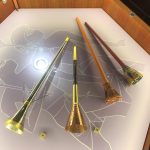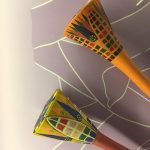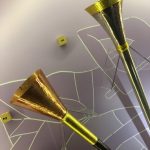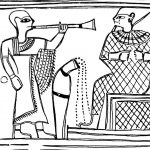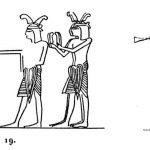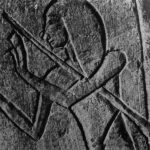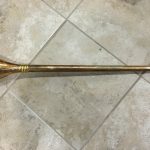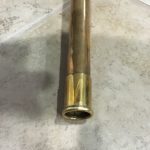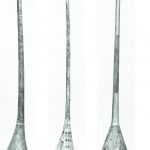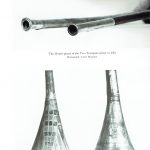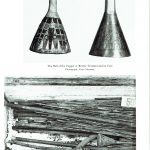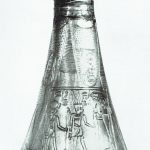THE "TUT" TRUMPETS
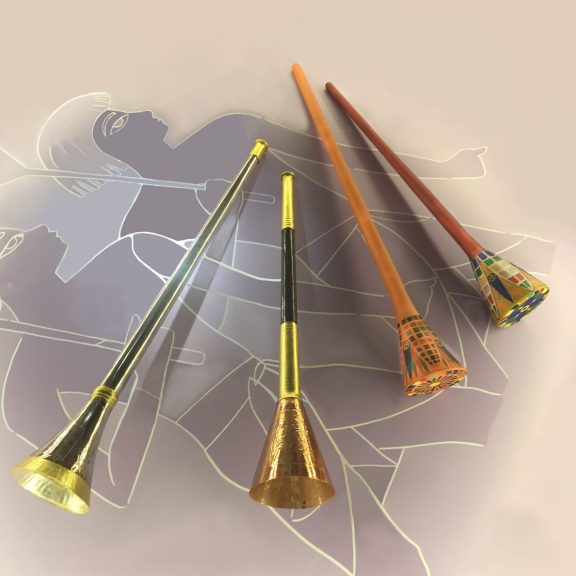
Replicas of Tutankhamun's Trumpets by Dr. Peter Holmes
The European Music Archeology Project (EMAP) exhibition, Valladolid, Spain
The "Tut" Trumpets
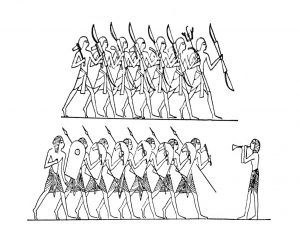
The "Tut" trumpet is the nickname that Dr. Peter Holmes uses when he talks about the trumpets that were discovered in the tomb of the Egyptian King Tutankhamun (c. 1341 – c. 1323 BCE), also known as "King Tut." Before these trumpets were found, archeologists had studied iconography (images) of Egyptians playing straight trumpets called Šnb ("sne-heb") in the Egyptian written symbols known as hieroglyphics. Šnb are shown most often directing troops in battle, but they are also depicted with the Egyptian God of the afterlife, Osiris, who was believed to have invented the trumpet.
British archeologist Howard Carter found Tutankhamun's tomb in 1922. It took eight years to remove the 5,000 items that were found inside, which were taken to the Cairo museum in Egypt. Among the treasures they found were two trumpets, one made of copper and the other of silver, that looked exactly like the ones seen in iconography. This is how experts were certain that the objects were trumpets, because the images showed them being held up to the mouth to be played.
In 1939 a British trumpeter was asked to play both trumpets for a live BBC radio broadcast - a momentous occasion since they had not been heard for over 3,000 years. The trumpets were very fragile though, and to the horror of the onlooking King of Egypt, the trumpeter tried to stick his modern trumpet mouthpiece into the end, severely damaging one of the trumpets. Fortunately it was repaired, and both trumpets were played for a live BBC radio broadcast, but with the use of a modern mouthpiece. The mouthpiece of the Šnb is simply a ring attached to the end of the tube (see gallery below) which makes it very challenging to play for a modern trumpeter. Also, the notes that can be played sound very different when a modern mouthpiece is used, so what the world heard on the radio in 1939 probably wasn't how the trumpets would have sounded 3,000 years ago. Regardless, it captured the imagination of people everywhere, and Tutankhamun's trumpets often tour around the world as part of an exhibition of his treasures to this day.
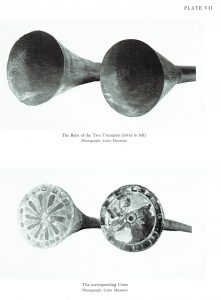 One of the unique features of the "Tut" Trumpets is that they were found with wooden cores inserted, colorfully painted to look like the flowers and stems of a lotus. No one knows for sure why the trumpets had cores. They could have been used as mandrels (forms) to help in construction of the trumpets, or they could have been used to protect the trumpets during transportation. Having studied these trumpets extensively (and having made numerous replicas over the years), Dr. Peter Holmes believes that the cores had a symbolic meaning. When the trumpet was not being played, the core would be hidden inside, just as the lotus disappears into the water at dusk. When the core was removed, the voice of the trumpet could sound again, just as the lotus flower reappears with the rising sun, renewed and reborn. These cores may have been made especially for the trumpets that were buried with Tutankhamen, so that when he was reborn into the next life, the cores could be removed, and the trumpets would sound again.
One of the unique features of the "Tut" Trumpets is that they were found with wooden cores inserted, colorfully painted to look like the flowers and stems of a lotus. No one knows for sure why the trumpets had cores. They could have been used as mandrels (forms) to help in construction of the trumpets, or they could have been used to protect the trumpets during transportation. Having studied these trumpets extensively (and having made numerous replicas over the years), Dr. Peter Holmes believes that the cores had a symbolic meaning. When the trumpet was not being played, the core would be hidden inside, just as the lotus disappears into the water at dusk. When the core was removed, the voice of the trumpet could sound again, just as the lotus flower reappears with the rising sun, renewed and reborn. These cores may have been made especially for the trumpets that were buried with Tutankhamen, so that when he was reborn into the next life, the cores could be removed, and the trumpets would sound again.
Brass for Beginners authors Dr. Kirsty Montgomery and Chris Hasselbring first met Dr. Peter Holmes at the EMAP conference in Italy in 2015, where he presented several ancient trumpet replicas he had made to the attendees. One of them was a copy of the silver "Tut" trumpet, which was played as part of a demonstration by Italian trumpeter Gabriel Cassone. After the conference was over, to our astonishment, Dr. Holmes gave us his "Tut" trumpet, and we have been sharing it with teachers and their students ever since. (see video below). Since that time, he was commissioned to make detailed replicas, including the cores, for the European Music Archeology Project's (EMAP) touring exhibition.
Did you know that you can make your own Egyptian Šnb? Dr. Holmes helped us to create instructions for making a playable Šnb which you can download here. Thank you Peter!
